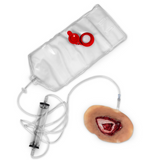
Simulaids
Life/form Moulage Wound - Open Skull Fracture Simulator
The Life/form Moulage Wound - Open Skull Fracture Simulator is a specialized medical training tool designed to simulate a realistic open skull fracture for educational purposes. This simulator is used to train healthcare professionals, first responders, and students in assessing, managing, and treating traumatic head injuries.
Key Features and Components:
-
Realistic Wound Simulation: The simulator features a lifelike moulage wound that replicates the appearance of an open skull fracture, including visible bone fragments, scalp lacerations, and exposed brain tissue. This realism allows learners to practice assessing the severity of the head injury and performing appropriate interventions.
-
Anatomical Accuracy: The moulage wound is anatomically accurate, incorporating details of the skull anatomy, bone structure, brain matter, and scalp tissue to enhance the realism of the simulation.
-
Durable Construction: The simulator is constructed using materials that closely resemble human tissues, providing a tactile and visual experience similar to real skull and scalp tissues.
-
Versatile Application: The open skull fracture simulator can be used in various medical training scenarios, including trauma care simulations, emergency response drills, and neurosurgical training exercises.
-
Reusable and Interchangeable: The moulage wound can be easily attached to a training manikin or standardized patient for repeated use. Additional wounds or injuries may be available for interchangeability, allowing for diverse training scenarios.
-
Training Accessories: Some simulators may come with additional components, such as simulated blood, wound dressing materials, and tools for practicing cranial stabilization techniques.
Benefits and Educational Value:
-
Enhanced Realism: The simulator provides a highly realistic representation of an open skull fracture, helping learners develop skills in injury assessment, cranial stabilization, and emergency neurosurgical interventions.
-
Hands-On Learning: Healthcare professionals can practice applying protective measures, bandages, or other interventions appropriate for skull fractures in a controlled training environment.
-
Patient Communication Skills: The simulator facilitates communication and interaction between healthcare providers and simulated patients, enhancing teamwork and communication skills during critical care scenarios.
-
Curriculum Integration: The open skull fracture simulator can be integrated into medical education curricula to supplement classroom learning with hands-on simulation experiences focused on neurotrauma and critical care management.
Shipping & Returns
Shipping Information
All orders are processed upon receipt (excluding weekends and select legal holidays) after receiving your order confirmation email. You will receive another notification when your order has shipped. MediTac proudly ships to our Armed Forces APO/FPO customers.
Delivery Time & Delays
Delivery time on most orders is up to 7 business days within the contiguous 48 states. In the event of delays, every effort will be made to contact you by phone, e-mail or mail. Actual shipping time is dependent on:
- Availability of merchandise
- Weather or other natural conditions
- Carrier operating schedules, delays or disruptions
- Credit verification & payment processing
- Pharmaceutical authorization if applicable
Domestic Shipping Rates and Estimates
Shipping charges for your order will be calculated and displayed at checkout. Orders 50 or more qualify for free freight. Excludes first aid cases.
International Shipping
For international orders & shipments, or for more information about shipping & the availability of products, please feel free to contact us at info@meditackits.com.
Your order may be subject to import duties and taxes (including VAT), which are incurred once a shipment reaches your destination country. MediTac is not responsible for these charges if they are applied and are your responsibility as the customer.
How do I check the status of my order?
When your order has shipped, you will receive an email notification from us which will include a tracking number you can use to check its status. Please allow 48 hours for the tracking information to become available.
If you haven’t received your order within 7 business days of receiving your shipping confirmation email, please contact us at info@meditackits.com with your name and order number, and we will look into it for you.
Refunds, returns, and exchanges
We have a 30-day return policy, which means you have 30 days after receiving your item to request a return.
To be eligible for a return, your item must be in the same condition that you received it, unworn or unused, with tags, and in its original packaging. You’ll also need the receipt or proof of purchase.
In the event that your order arrives damaged in any way, please email us as soon as possible at info@meditackits.com with your order number and a photo of the item’s condition. We address these on a case-by-case basis but will try our best to work towards a satisfactory solution.
If you have any further questions, please don't hesitate to contact us at info@meditackits.com.

HSA/FSA Approved
Flexible Spending Account and Health Savings Account eligible item.

Assembled in the United States
By New Yorkers

Quality Components
By Professional Control Team

Hand-Picked by Medical Pros
Career First Responders
Shop by Type
Join Our List
Stay in the Loop—Subscribe for Updates & Savings


























































